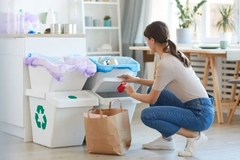US researchers combine crustacean and seaweed composites for high-strength biopolymer film

20 Dec 2023 --- Researchers at North Carolina State (NC State) University, US, are using crustaceans and seaweed to create biopolymer films that they say have exceptional strength, high visible light transmittance, improved hydrostability and high bactericidal activity. The team believes its R&D could prove a significant milestone in biopolymer production.
The study authors combined chitosan, a biopolymer that strengthens crab shells, with agarose, a biopolymer extracted from seaweed traditionally used to make gels.
This combination creates “unique” biopolymer composite films with enhanced strength, according to Doris Culberson, professor of chemical and biomolecular engineering at NC State.
The films are also biodegradable, have antibacterial properties, repel water and are transparent. The findings could eventually produce packaging films for food and consumer goods, says Dr. Culberson and co-author Dr. Yosra Kotb.
The biopolymer composites are approximately four times stronger than agarose films and also resist E.coli, the research finds. The paper also showed that a sheet made from biopolymer composite films greatly degraded after a month underground. In comparison, a common plastic sandwich bag remained completely intact after the same period underground.
Scientific advances, policy backtracks
Mixing chitosan and agarose together is not necessarily enough to produce effective biopolymer films. Previous efforts to create such mixtures reported property improvements, but when dried, gritty films that lacked sufficient strength resulted.
Instead, Velev and his collaborators took an alternate approach, reinforcing the agarose films with fibrillated colloidal scale material — called soft dendritic colloids made from chitosan. The chitosan micro- and nanoscale fibrils are embedded and hierarchically branched to strengthen and stabilize the agarose film.
Using chitosan dendritic particles to reinforce the agarose matrix works because of the compatibility of both materials, which leads to effective mechanical properties, according to the research. Chitosan particles also have an opposite charge to agarose. When mixed, these charges are neutralized, making the resulting materials more resistant to water.
Recently, European Bioplastics expressed disappointment at the EU’s Packaging and Packaging Waste Directive votes, saying policies “barely recognize” the value of “a very short number of compostable applications and hindering biobased innovative solutions.”
“EUBP supports the European Parliament’s proposal for a Regulation on Packaging and Packaging Waste. We call on the member states and the incoming Belgian Presidency to work in close cooperation with the Parliament, which has been showing clear leadership on the file,” asserted Hasso von Pogrell, managing director at EUBP.
Edited by Louis Gore-Langton











